
How to use search volume for competitor analysis?

Antonio Gabrić
February 11, 2024
Learn how to leverage keyword search volume data to gain insights into your competitors' online presence and tailor your strategy for success!

61% of B2B marketers state that SEO and organic traffic generate more leads than any other marketing channel. This means there are a bunch of competitors trying to take the piece of the cake.
Understanding your competitors' strategies is crucial for SEO and digital marketing success. One of the most valuable data points for competitor analysis is search volume – the number of monthly searches for a particular keyword.
Analyzing your competitor's target keywords gives insight into what topics drive traffic to their site. You can then refine your SEO and content strategy to focus on high-potential search terms.
In this guide, we'll cover everything you need to know about using search volume data for smarter competitor analysis – from identifying and finding gaps to outranking your competitors.
Understanding Search Volume and Its Role in SEO
Search volume refers to the estimated number of monthly searches people do for a specific keyword in search engines. This number is calculated by taking the average number of searches during a specific time frame.
Search volume significantly influences SEO strategy, especially in keyword research. This metric gives you an idea of the search interest and the traffic potential for keywords.
Search volume also has a predictive power for upcoming trends. Changes in search volume foreshadow shifts in consumer demand and interest.
For example, a spike in searches for “backcountry skiing” from January to March signifies the rising demand for the sport.
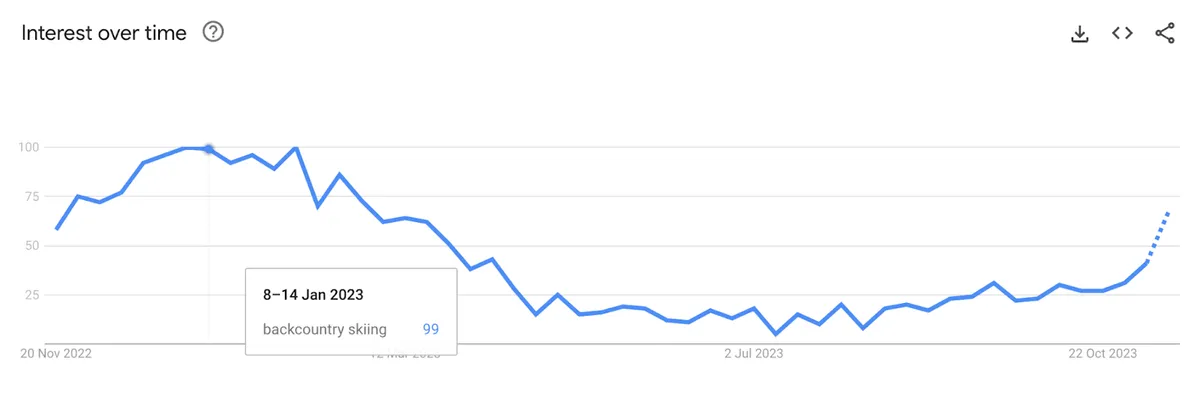
If you were to be a company dealing with skiing, that would be the best time to focus on creating and promoting content for skiing.
Monitoring search volume over time gives you an early signal of rising topics and changing interests. This allows you to stay on top of your competitors.
Identifying Your Competitors
Let’s say you run a backcountry ski tour company in Colorado.
Your direct competitors are businesses that offer similar products and services. In this case, your direct competitors would be other backcountry ski tour providers in Colorado.
You can easily find them by Googling for the main keyword you target: guided backcountry skiing colorado.

Indirect competitors cater to your broad interest and audience but offer different solutions. In this case, your indirect competitors would be websites that target keywords such as skiing in Colorado.
Let’s do a quick Google search and check what we got.
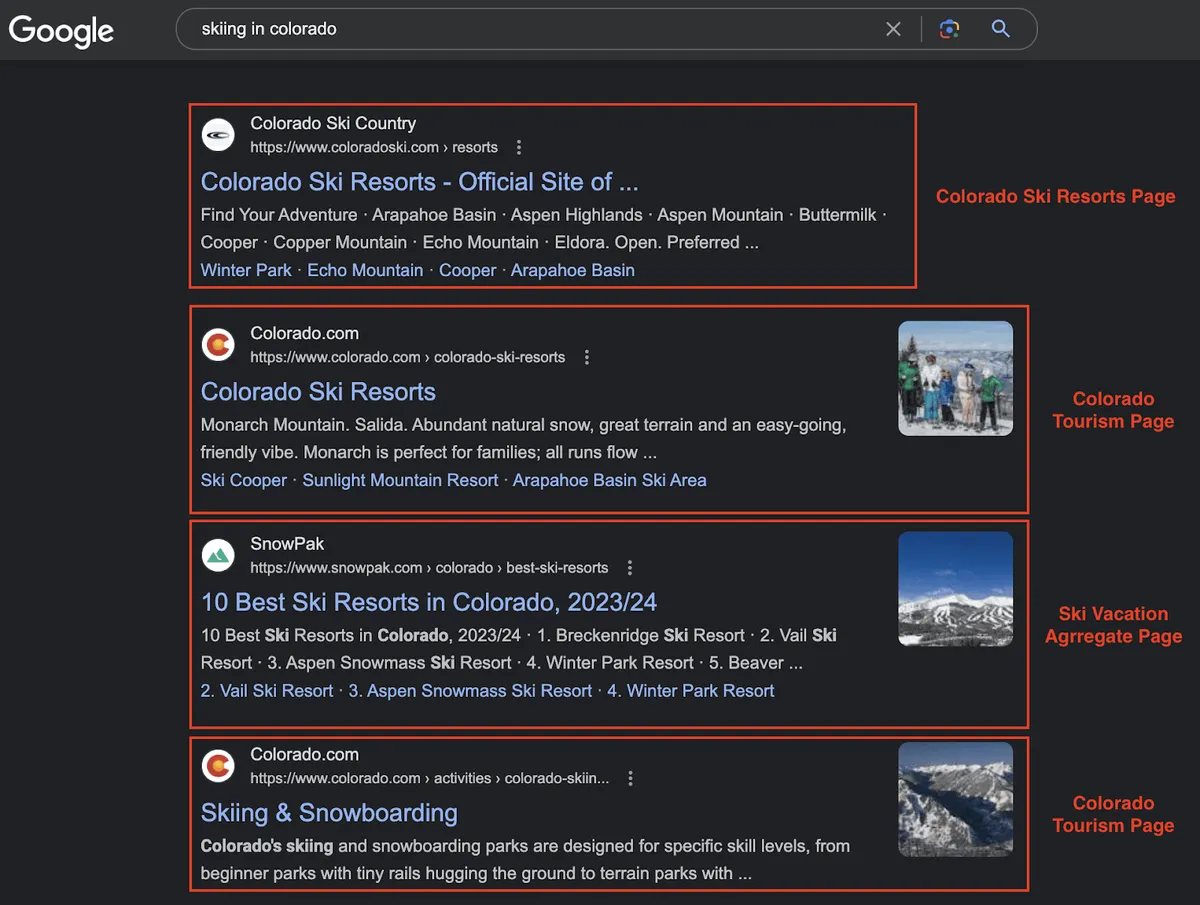
At first glance, your indirect competitors don’t strictly focus on offering backcountry skiing tours, like you do.
Analyzing Competitors' Keyword Strategies
Now that you have a competitor list, it’s time to analyze their keyword targeting strategies using keyword data. This reveals the specific terms and topics driving traffic to their site.
Strategy 1: Analyze the keyword overlap and gaps between your site and competitors.
With the help of an SEO tool, you can find competing websites with a high percentage of keywords overlapping with your website. This can help you find more organic competitors than the manual method.
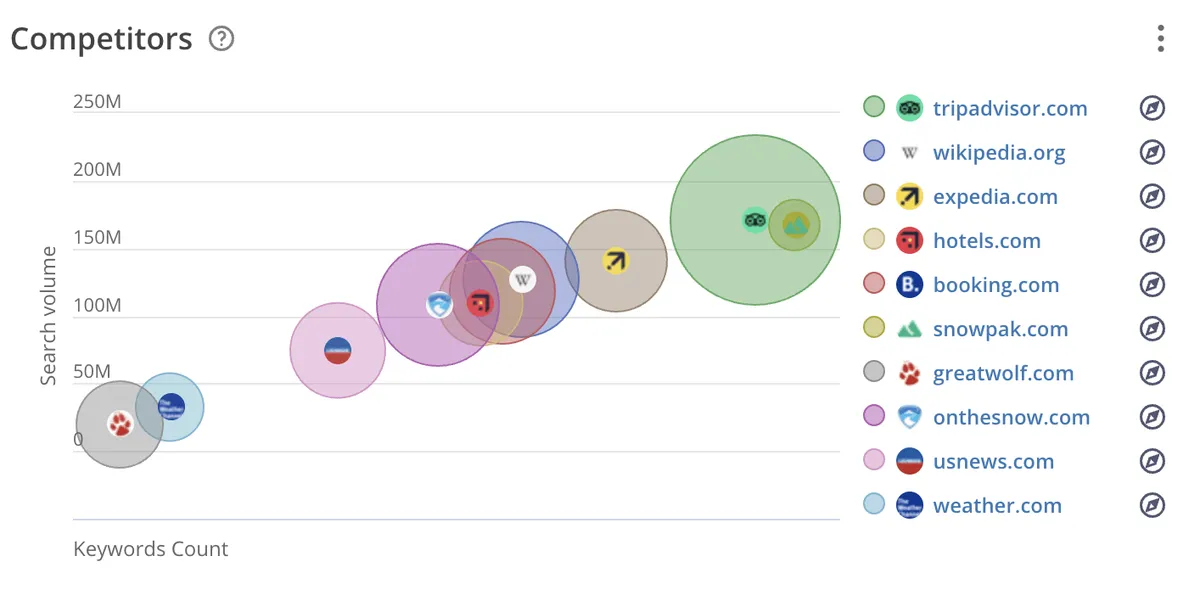
You can use any big SEO tool to find content gaps – keywords your competitors rank for, but you don’t. This is a great way to find keyword opportunities to capitalize.
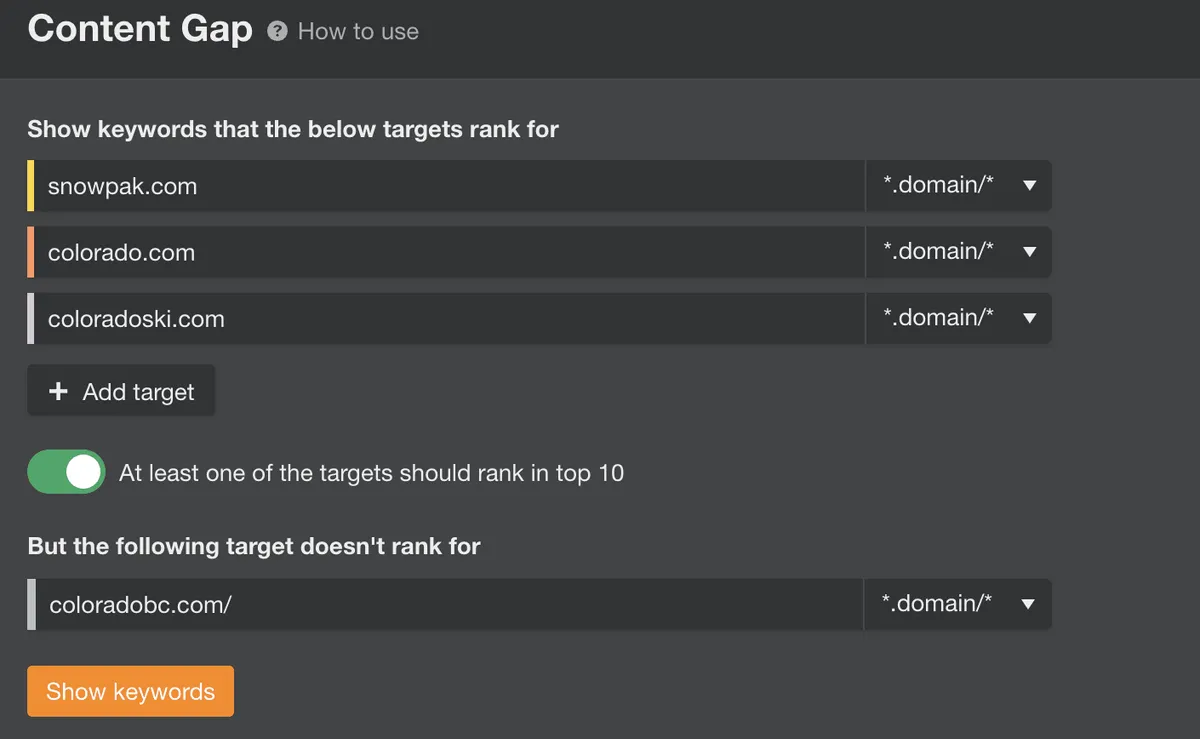
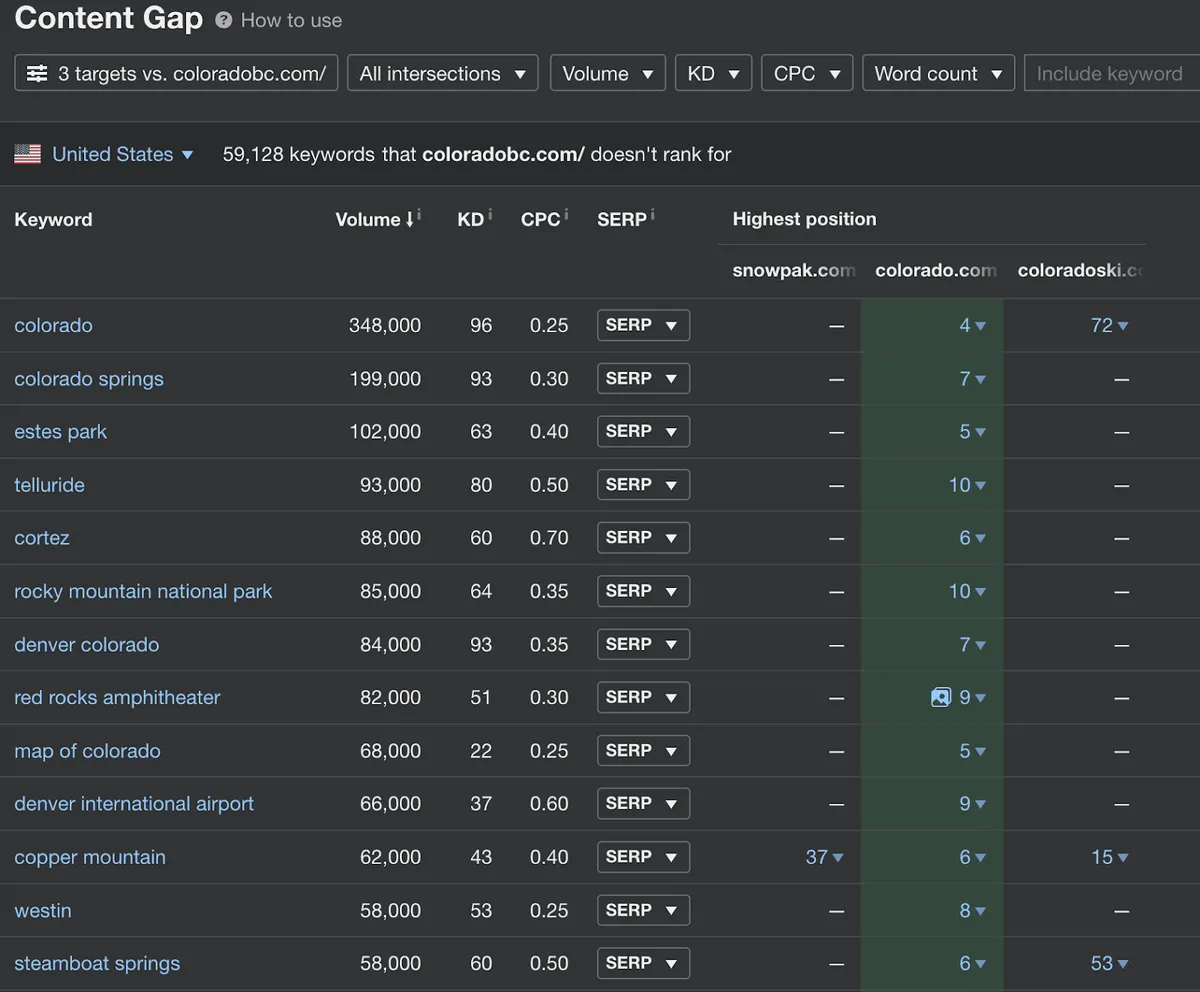
You can use a filter to find more relevant keyword ideas from your competitors. Think of a keyword very relevant to your niche; in this case, it is ski or skiing. You will get more relevant keyword ideas to target once you input one of these as a filters.
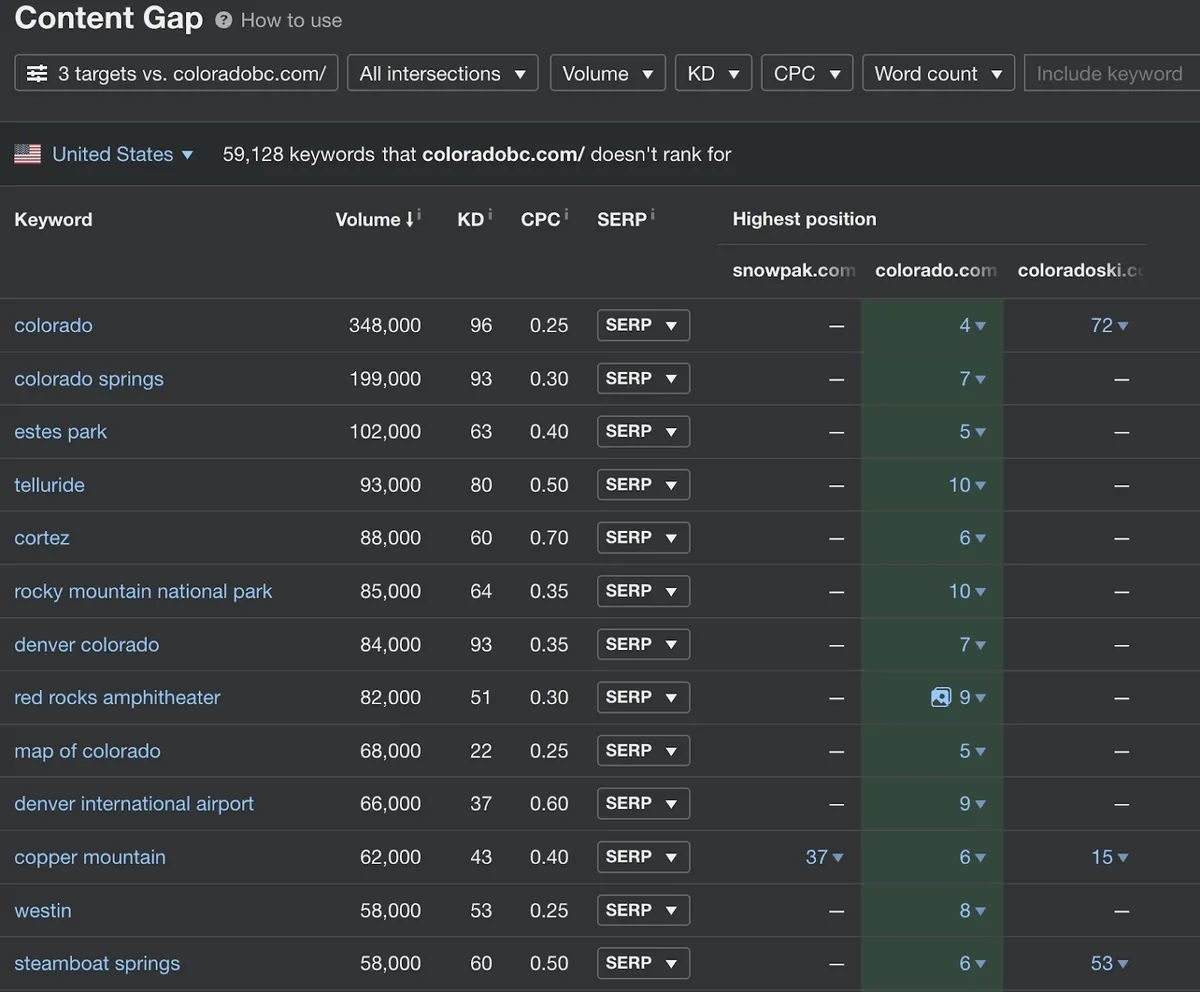
Strategy 2: Evaluate the search volume to understand keyword priority and potential traffic.
The higher the search volume, the higher the traffic potential of the topic – if you can rank well. Let’s take one of the competitor’s domains and analyze its top keywords.
In this case, the competitor is ranking first for resorts in colorado for skiing keyword, which might be a good topic to target. We can also see that they get approx. 9,532 organic traffic from a single keyword. Still, it will be hard to outrank them as they rank first. Let’s check for which keywords the page is ranking to find more opportunities.
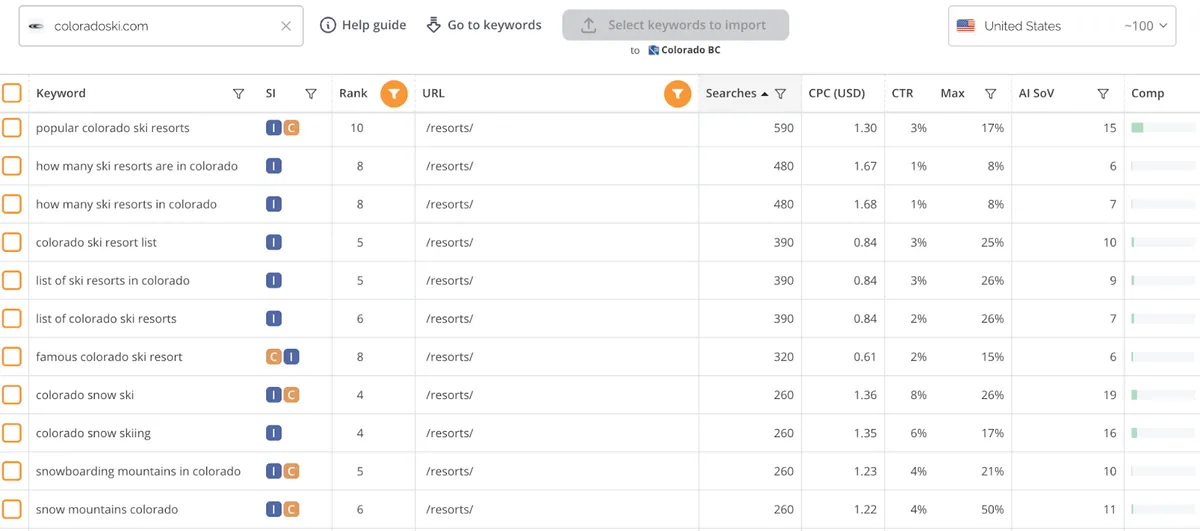
It's a different story when you filter for keywords that rank from position 4 to 10. Notice that the search volume for these keywords is noticeably lower. These might be considered long-tail keywords, representing quick wins to outrank your competitor, as most of all keywords are considered long-tail.
Strategy 3: Use tools to assess the difficulty and opportunity of ranking for these keywords.
Volume alone doesn’t determine keyword value. You also need to evaluate the difficulty and your capability to outrank your competitors. Most SEO tools have a keyword difficulty metric that will help you determine the difficulty of ranking for a specific keyword.

The best practice is to target “easy” keywords, as you can easily outrank competitors, even if they already have high traffic.
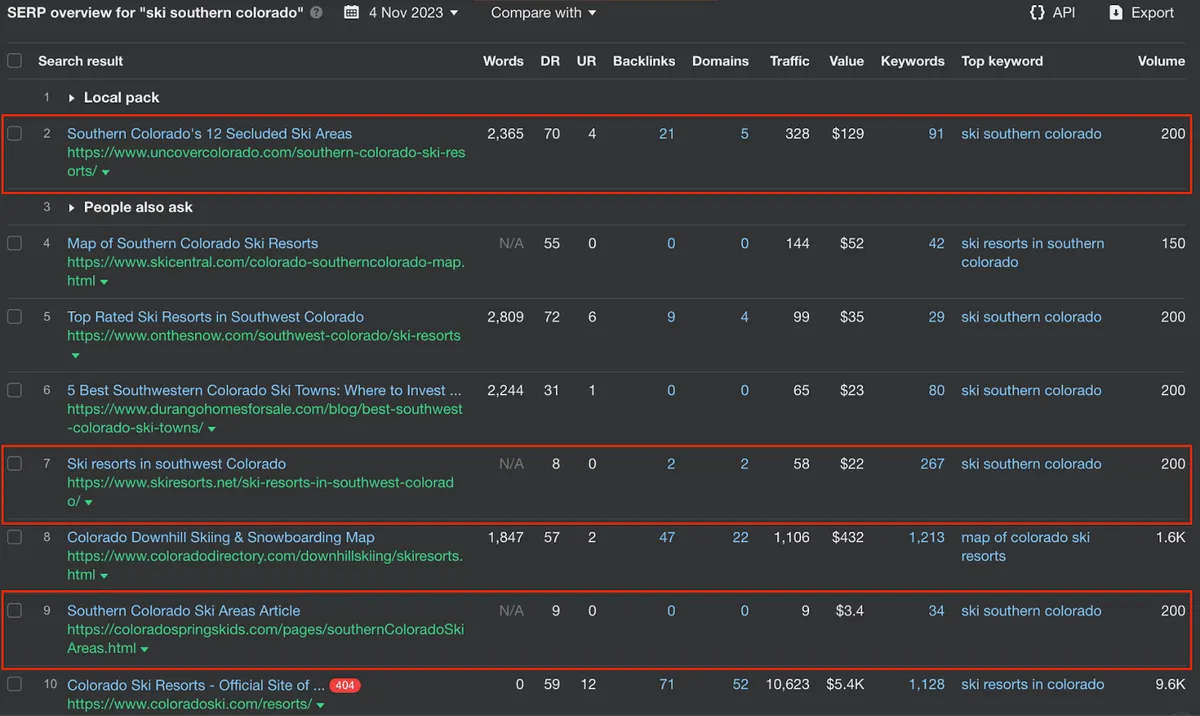
In this case, even though there is a high DR (Domain Authority) site ranking second; we can see two low DR websites ranking, which means we could easily outrank these and rank in the top 5 results for this keyword.
Using Search Volume to Uncover Competitor Traffic
When it comes to traffic estimation for a specific keyword, you can use the CTR statistics to provide a calculation for the first three positions. Let’s see this for ski southern colorado keyword.
Keyword Traffic = Search Volume x Click-through-rate
For this particular keyword, the situation would be like this:
Position 1: 200 x 39,8% = 80 visits per month
Position 2: 200 x 18,7% = 37 visits per month
Position 3: 200 x 10,2% = 43 visits per month
To simplify things, you can use an SEO tool to find out how different websites capture the traffic for a specific keyword:
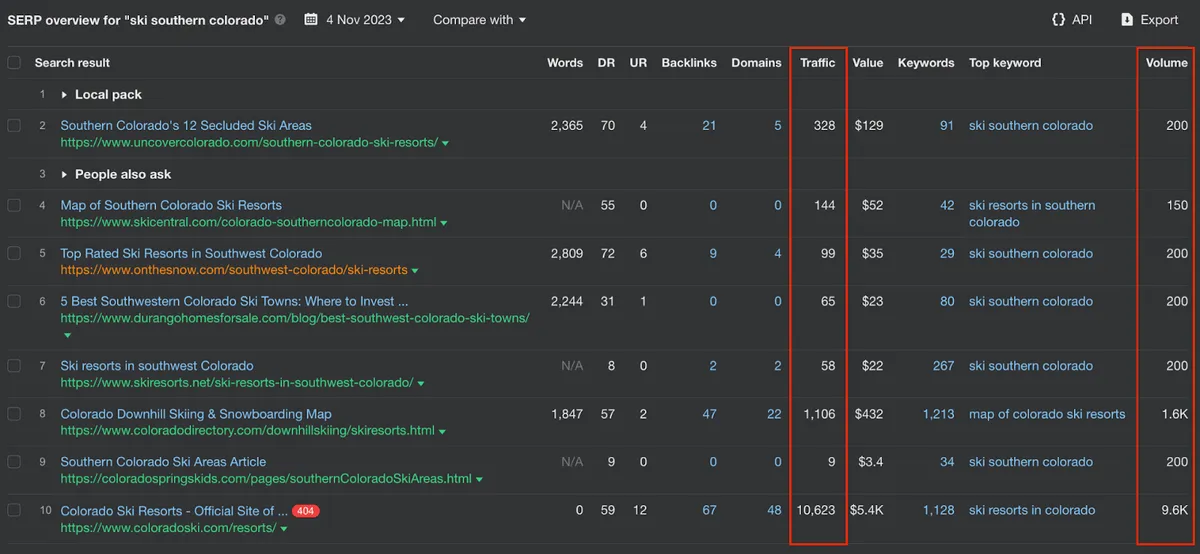
When a website targets a specific keyword, it may rank for numerous other keywords. This makes calculating traffic with a manual method tough and time-consuming.
Checking the traffic for a page as compared to the keyword volume of the top keyword can outline how successful a website is at dominating search results. It can also give you an indication of how much traffic you can get if you outrank a page in the top 10 results.
Analyzing Competitor Content Using Search Volume Data
Search volume can also help analyze competitors' content strategies. You can identify the topics and formats attracting the most search interest on their site.
Let's walk through a 3-step process for evaluating competitors' content using search volume data:
Step 1: Map competitors' content to their targeted high-volume keywords.
Use an SEO tool to see which competitor pages rank for their top keywords by volume.
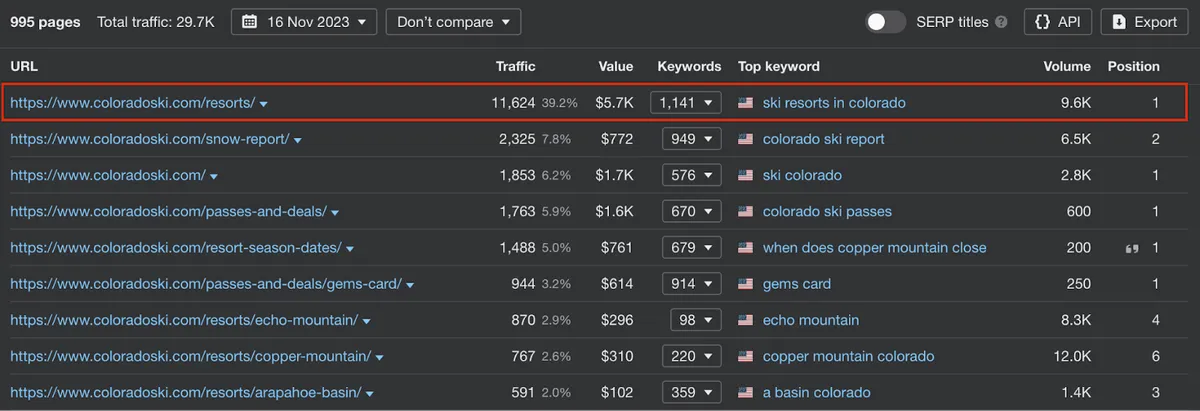
This reveals their important traffic-driving content. Focus your analysis on these pages to evaluate their approach to keyword-focused content.
You may notice they allocate significant resources to optimizing just a handful of pillar pages for core topics. Or they may take a long-tail approach with thousands of posts targeting niche long-tail keywords.
In this case, it is a bit of both – although this competitor has almost 40% of traffic on one page, so let’s see what are they doing well here.
Step 2: Assess the content quality and keyword optimization techniques used.
Next, dive into the high-value page identified in step 1.
Assess factors like:
How prominently do they feature the keyword
Use of supporting keywords and LSI phrases
Quality of content for user experience
Internal links to support pages
Overall depth and uniqueness of content
This helps you gauge how effectively they optimize and structure their pages for keywords. You can identify strengths to emulate or weaknesses to improve upon.
Also check their focus on keyword intent to align content to informational, commercial, or navigational searches.
Let’s check the high-value page from the competitor:

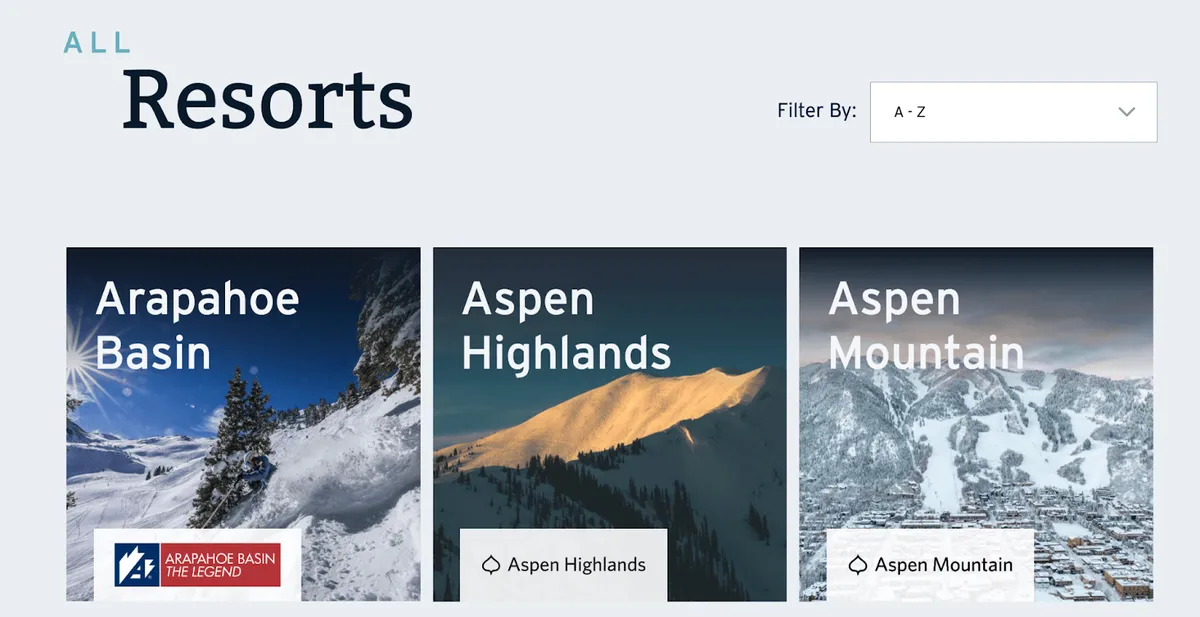
They don’t feature the ski resorts in colorado keyword, although they use a couple of supporting keywords, such as Colorado winter getaway. The competitor has modeled this page as a navigational page – internally linking to all the relevant ski resorts, improving the user experience.
In this case, the opportunities would be:
Optimizing content more around the ski resorts in colorado keyword and other long-tail keywords the competitor doesn’t rank for well.
Writing more in-depth content about the ski resorts, perhaps going for the listicle format.
Always use the competitor’s content as inspiration – but never copy it.
Top trick: You can use web scraping to stay informed about your competitors' content,
Step 3: Analyze user engagement metrics to gauge content performance.
Look beyond optimization to evaluate real user engagement on competitor pages.
Use an SEO tool to check engagement signals, such as backlinks and traffic.
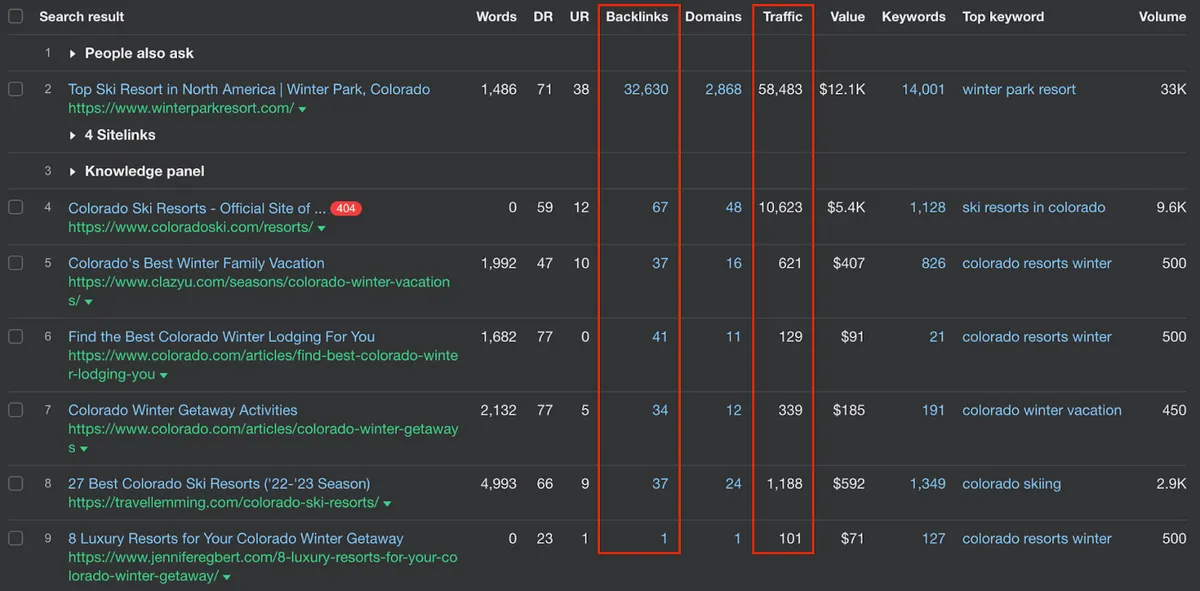
Poor engagement signals their high-ranking content isn’t satisfying searchers. This is a gap you can fill with more compelling content optimized for those keywords.
Taking this data-driven approach helps you create content that outperforms competitors by better serving searchers.
Actionable Strategies to Outrank Competitors
The goal of competitor analysis is to identify strategic opportunities to surpass their rankings.
Here are 3 key strategies to keyword insights offensively against your competitors:
Strategy 1: Optimize for untapped high-volume keywords identified in the competitor analysis.
Find lucrative keywords competitors already rank for; but you have not yet targeted. Assess whether the comparatively high search volumes make them worth pursuing.
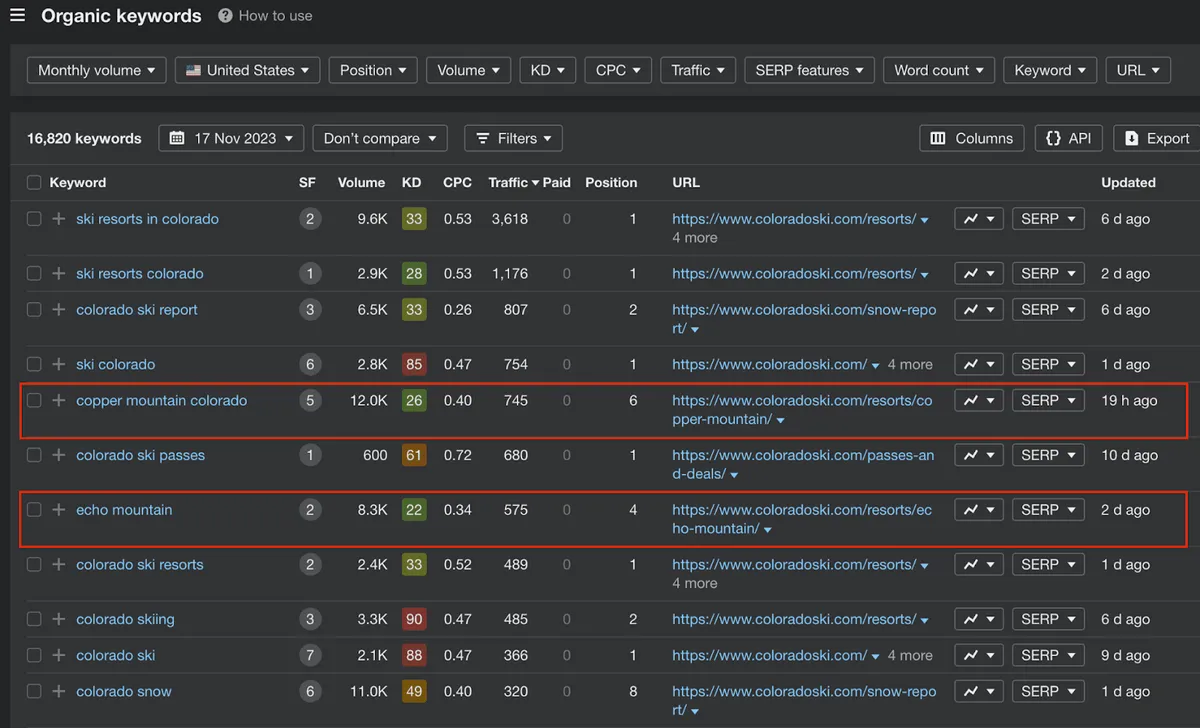
For example, a backcountry ski tour website may determine competitors are heavily optimizing for keyword variations around ski resorts in Colorado which they have surprisingly neglected on their own site. The sizable search volume presents a strong incentive to develop content pillars around that theme to tap into demand.
Going after competitors' unchallenged keywords allows you to divide up the search market share.
Strategy 2: Develop content that addresses gaps in competitors' keyword coverage.
Find gaps where competitors' content is weak or non-existent for high-volume keywords. Then, produce superior content focused on those topic holes to siphon away their traffic.
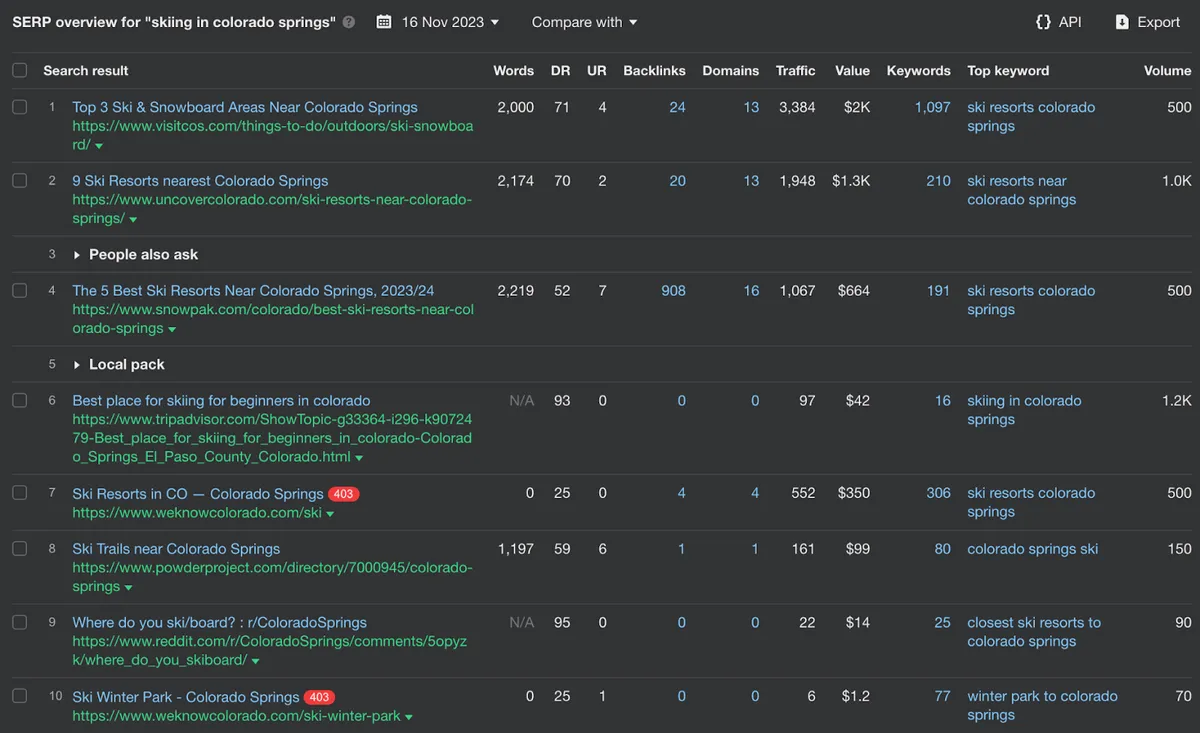
For example, a backcountry ski tour could create a guide targeting the keyword skiing in colorado springs and focus on covering other areas apart from ski resorts.
Strategy 3: Monitor search volume trends to pivot strategy as needed.
Leverage keyword analysis tools to check the changing search trends for specific keywords, especially if you are in a seasonal niche.

Since our example is based on skiing in Colorado, a highly seasonal niche, you might experience highs from November to March, and lows in between.
It is smart to prepare for the upturn in search volume for all seasonal keywords by writing and optimizing content tailored to that niche – so that you can capitalize on the temporary boost in searches.
Tools for Competitor Search Volume Analysis
As 60% of marketers use 4-6 different tools for SEO, their value is undoubtable. Here are the best tools you can use for competitor analysis:
| Tool | Features | Pricing |
|---|---|---|
| Accuranker | Track up to 50,000 keywords Share of Voice of domains Aggregated SERP analysis Keyword gap and overlap tracking | 14-day free trial without credit card, then from 116 USD/month (1,000 keywords) to 2,492 USD/month (50,000 keywords) |
| SEMrush | Track up to 5,000 keywords Find keywords driving traffic to individual pages Keyword Gap feature to reveal page strategy holes | 7-day free trial, then from 129,95 USD/month (500 keywords) to 499,95 USD/month (5,000 keywords) |
| Ahrefs | Track up to 10,000 keywords Find keywords driving traffic to individual pages Content Gap feature to reveal page strategy holes | No free trial, 99 USD/month (750 keywords) to 999 USD/month (10,000 keywords) |
Wrapping Up
The search results constantly change, as Google makes 500-600 algorithm changes yearly. Staying one step ahead starts with competitor analysis.
By digging into keywords your competitors target, you gain actionable insights on high-potential keywords, untapped opportunities, and content gaps. You can then adjust your own SEO and content strategies accordingly.
Use these tips and tools to gain an ongoing view into the keyword landscape and dominate your niche.
Related blog posts

AI Overviews Are Taking Over SERPs
From traffic drops to decreasing CTRs, AI Overviews are shaking up SEO. Learn what is happening and how AccuRanker helps you track AIO.
25 June 2025
How AccuRanker’s AI Models Fix Inaccurate SEO Data
Struggling with unreliable SEO data? Discover how AccuRanker’s CTR, Search Intent, Search Volume, and Share of Voice deliver accurate insights.
1 June 2025
Why Your CTR Model Is Betraying You
The static CTR model relies on outdated averages. Learn more about how AccuRanker's dynamic CTR model helps you prioritize your SEO efforts.
13 May 2025



